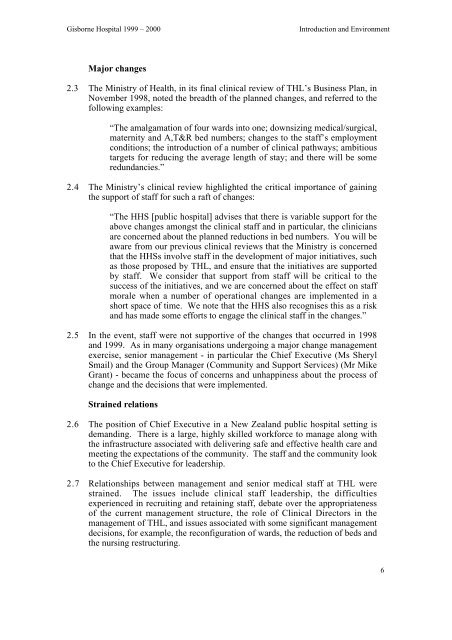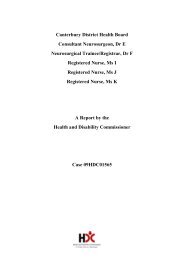Gisborne Hospital Report - Health and Disability Commissioner
Gisborne Hospital Report - Health and Disability Commissioner
Gisborne Hospital Report - Health and Disability Commissioner
Create successful ePaper yourself
Turn your PDF publications into a flip-book with our unique Google optimized e-Paper software.
<strong>Gisborne</strong> <strong>Hospital</strong> 1999 – 2000<br />
Introduction <strong>and</strong> Environment<br />
Major changes<br />
2.3 The Ministry of <strong>Health</strong>, in its final clinical review of THL’s Business Plan, in<br />
November 1998, noted the breadth of the planned changes, <strong>and</strong> referred to the<br />
following examples:<br />
“The amalgamation of four wards into one; downsizing medical/surgical,<br />
maternity <strong>and</strong> A,T&R bed numbers; changes to the staff’s employment<br />
conditions; the introduction of a number of clinical pathways; ambitious<br />
targets for reducing the average length of stay; <strong>and</strong> there will be some<br />
redundancies.”<br />
2.4 The Ministry’s clinical review highlighted the critical importance of gaining<br />
the support of staff for such a raft of changes:<br />
“The HHS [public hospital] advises that there is variable support for the<br />
above changes amongst the clinical staff <strong>and</strong> in particular, the clinicians<br />
are concerned about the planned reductions in bed numbers. You will be<br />
aware from our previous clinical reviews that the Ministry is concerned<br />
that the HHSs involve staff in the development of major initiatives, such<br />
as those proposed by THL, <strong>and</strong> ensure that the initiatives are supported<br />
by staff. We consider that support from staff will be critical to the<br />
success of the initiatives, <strong>and</strong> we are concerned about the effect on staff<br />
morale when a number of operational changes are implemented in a<br />
short space of time. We note that the HHS also recognises this as a risk<br />
<strong>and</strong> has made some efforts to engage the clinical staff in the changes.”<br />
2.5 In the event, staff were not supportive of the changes that occurred in 1998<br />
<strong>and</strong> 1999. As in many organisations undergoing a major change management<br />
exercise, senior management - in particular the Chief Executive (Ms Sheryl<br />
Smail) <strong>and</strong> the Group Manager (Community <strong>and</strong> Support Services) (Mr Mike<br />
Grant) - became the focus of concerns <strong>and</strong> unhappiness about the process of<br />
change <strong>and</strong> the decisions that were implemented.<br />
Strained relations<br />
2.6 The position of Chief Executive in a New Zeal<strong>and</strong> public hospital setting is<br />
dem<strong>and</strong>ing. There is a large, highly skilled workforce to manage along with<br />
the infrastructure associated with delivering safe <strong>and</strong> effective health care <strong>and</strong><br />
meeting the expectations of the community. The staff <strong>and</strong> the community look<br />
to the Chief Executive for leadership.<br />
2.7 Relationships between management <strong>and</strong> senior medical staff at THL were<br />
strained. The issues include clinical staff leadership, the difficulties<br />
experienced in recruiting <strong>and</strong> retaining staff, debate over the appropriateness<br />
of the current management structure, the role of Clinical Directors in the<br />
management of THL, <strong>and</strong> issues associated with some significant management<br />
decisions, for example, the reconfiguration of wards, the reduction of beds <strong>and</strong><br />
the nursing restructuring.<br />
6
















